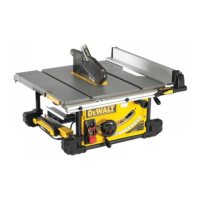12
ENGLISH
• Never reach in back of, or around, the cutting tool with
either hand to hold down theworkpiece.
• Keep arms, hands and fingers away from the blade to
prevent seriousinjury.
• Use a push stick that is appropriate to the application
to push workpieces through the saw. A push stick is a
wooden or plastic stick, often homemade, that should be used
whenever the size or shape of the workpiece would cause you
to place your hands within 152mm of theblade.
• Use hold-downs, jigs, fixtures or feather boards to help
guide and control the workpiece. Accessories for use with
your tool are available at extra cost from your local dealer or
authorized service centre.
• Do not perform ripping, crosscutting or any other
operationfreehand.
• Never reach around or over sawblade while the blade
isspinning.
• Stability. Make sure the table saw is firmly mounted to a
secure surface before use and does notmove.
• The table saw should only be set up on a level and stable
surface. The work area should be free from obstructions and
trip hazards. No materials or tools should be leaned against
thesaw.
• Never cut metals, cement board or masonry. Certain
man-made materials have special instructions for cutting on
table saws. Follow the manufacturer’s recommendations at all
times. Damage to the saw and personal injury mayresult.
• Do not install a diamond masonry blade and attempt to use
the table saw as a wetsaw.
• The proper throat plate must be locked in place at all
times to reduce the risk of a thrown workpiece and
possibleinjury.
• Wear gloves when handling sawblades.
• Use the correct saw blade for the intended operation.
The blade must rotate toward the front of the saw. Always
tighten the blade arbor nut securely. Before use, inspect the
blade for cracks or missing teeth. Do not use a damaged or
dullblade.
• Never attempt to free a stalled saw blade without first
turning the machine off and disconnect tool from power
source. If a workpiece or cut-off piece becomes trapped inside
the blade guard assembly, turn saw off and wait for blade to
stop before lifting the blade guard assembly and removing
thepiece.
• Never start the machine with the workpiece against
the blade to reduce the risk of a thrown workpiece and
personalinjury.
• Do not have any part of your body in line with the blade.
Personal injury may occur. Stand to either side of theblade.
• Never perform layout, assembly or set-up work on the
table/work area when the machine is running. A sudden
slip could cause a hand to move into the blade. Severe injury
canresult.
• Never perform any adjustments while the saw is running
such as fence repositioning or removal, bevel lock
adjustment, or blade heightadjustment.
• Clean the table/work area before leaving the machine.
Lock the switch in the “OFF” position and disconnect tool from
power source to prevent unauthorizeduse.
• Always lock the fence and bevel adjustment
beforecutting.
• Avoid overheating the saw blade tips. Keep material
moving and parallel with the fence. Do not force work into
theblade.
• If cutting plastic materials, avoid melting theplastic.
• Do not leave a long board (or other workpiece)
unsupported so the spring of the board causes it to shift
on the table resulting in loss of control and possible
injury. Provide proper support for the workpiece, based on its
size and the type of operation to be performed. Hold the work
firmly against the fence and down against the tablesurface.
• If this saw makes an unfamiliar noise or if it vibrates
excessively, cease operating immediately, turn unit
off and disconnect tool from power source until the
problem has been located and corrected. Contact a
factory service centre, a
authorized service
centre or other qualified service personnel if the problem can
not befound.
• Do not operate this machine until it is completely
assembled and installed according to the instructions. A
machine incorrectly assembled can cause seriousinjury.
• Never attempt to cut a stack of loose pieces of material
which could cause loss of control or kickback. Support all
materialssecurely.
Saw Blades
WARNING: to minimise the risk of kickback and to ensure
proper cutting, the splitter and riving knife must be the
proper thickness for the blade used. If a different blade
is used, check the blade body (plate) thickness and the
blade kerf (cutting) width marked on the blade or on the
blade packaging. The splitter and riving knife thickness
must be greater than the body thickness and less than the
kerfwidth.
• Do not use saw blades that do not conform to the dimensions
stated in the Technical Data. Do not use any spacers to make
a blade fit onto the spindle. Use only the blades specified in this
manual, complying with EN847-1, if intended for wood and
similarmaterials.
• Consider applying specially designed noise-reductionblades.
• Do not use high steel (HS) sawblades.
• Do not use cracked or damaged sawblades.
• Ensure that the chosen saw blade is suitable for the material
to becut.
• Always wear gloves for handling saw blades and rough
material. Saw blades should be carried in a holder
whereverpracticable.

